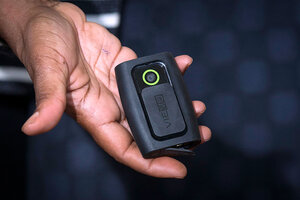New York police test body cameras: Effective deterrent or privacy violation?
Police Commissioner Bill Bratton said body-worn cameras are 'the next wave' in police equipment. But they come with unanswered privacy questions, such as when the cameras will be turned on and who will have access to the stored files.

New York City Public Advocate Letitia James displays a body-mounted camera during a news conference in New York, August 21, 2014. James is advocating for members of the New York City Police Department (NYPD) to use cameras to record their actions, which would possibly improve relations between police and local communities.
Brendan McDermid/Reuters
New York
After years of intense scrutiny of its street tactics, the New York Police Department announced Thursday that it would begin a pilot program to have its officers wear body cameras while on the beat.
Sixty cameras will be deployed for officers on patrol over the next few months. These will be distributed to one high-crime precinct in each of New York’s five boroughs, as well as to one public housing district, the department said.
Police Commissioner Bill Bratton said body-worn cameras are “the next wave” in the future of police equipment, comparing the technology to the introduction of hand-held radios and bulletproof vests in decades past. And he said their use would be beneficial to both cops and citizens during encounters on the street.
“The idea is the person understands that they are being recorded, and there is an ability to test the veracity through the use of the camera devices,” Commissioner Bratton said during a press conference Thursday. “Sometimes, being quite frank with you, complainants lie — bald-faced lies. And I think, clearly, the officer, knowing that it’s being recorded — in most instances it will affect the behavior of the officers in a good way. I think he or she will feel it’s an additional protection for them.”
The pilot program in the nation's largest police force comes after a summer of unrest in the city, sparked by the killing of Eric Garner in July, who was placed in an apparent chokehold, banned by police policy, after he resisted his arrest for allegedly selling loose cigarettes. The episode was vividly captured by bystanders’ smartphones, and is currently being investigated by the district attorney. In August, the medical examiner ruled Garner’s death a homicide.
The issue of police cameras – both body-worn and on the dashboards of cruisers – also came into sharp focus this summer after a police officer in Ferguson, Mo., shot and killed unarmed teen Michael Brown, sparking often-violent protests and roiling the nation's minority communities. The circumstances of the shooting are still disputed fiercely.
Body-worn cameras could help shed light on “he said, she said”-like controversies, Bratton said. "But it is not the end all."
Last summer, a federal judge ordered the NYPD to begin such a pilot program after she found the department’s use of stop-and-frisk to be an illegal shakedown of mostly minority citizens. The judge, Shira Scheindlin of New York’s southern district, ordered the department to have officers begin to wear cameras in at least five precincts across the city.
Despite the similarity, Bratton said the pilot program announced Thursday is “independent of the order.” The program, too, comes weeks before the US Justice Department is expected to issue guidelines on police-worn cameras.
Members of the NYPD’s rank and file reacted cautiously to the announcement. Patrick Lynch, president of the Patrolmen’s Benevolent Association, noted that his union is currently challenging Judge Scheindlin’s body-camera order in an appeal of last year’s stop-and-frisk ruling.
“Police officers have nothing to hide, but there are many unanswered questions as to how this will work practically,” Mr. Lynch said in a statement. “We await the answers.”
These questions include when the cameras would be turned on, what kind of recorded encounters would remain stored on police servers, and who would have access to these files. Many police officers expressed concern about confidential conversations that may be recorded by the technology, and whether their privacy would be protected.
“This is an extraordinarily complex initiative,” Bratton said, noting that specifics of the program remain to be worked out. “It is not simply going down to your local RadioShack, buying one of these things, and putting it on. The storage issue is phenomenal,” he added, and could cost millions of dollars per year to maintain.
Some community activists expressed disappointment, however, with the process.
“This kind of unilateral decision on the part of the NYPD follows the nontransparent, go-it-alone approach to police reform we saw with the prior NYPD and mayoral administration,” said Darius Charney, an attorney with the Center for Constitutional Rights, which brought the successful court challenge to the NYPD’s practice of stop-and-frisk
“The pilot project ordered by the court envisioned a collaborative process in which the City, plaintiffs and court monitor work together to develop the guidelines and procedures for how the cameras and the footage recorded on them would be used and stored,” Mr. Charney said in a statement Thursday.
But the “next wave” of policing with body cameras is already under way throughout the country, as thousands of departments have already begun issuing devices to record encounters, including in Ferguson.
NYPD officials observed new programs in Los Angeles, which began its pilot program this year in January, as well as San Francisco, Las Vegas, and other cities that have already begun to issue body-worn equipment.
“This pilot program will provide transparency, accountability, and protection for both the police officers and those they serve, while reducing financial losses for the city,” said New York Mayor Bill de Blasio, in a statement. “New York City will do everything it takes to stay the safest big city in the nation.”

